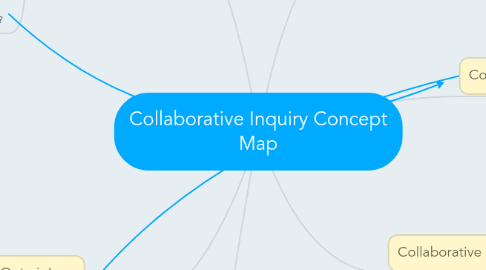
1. Explore More
1.1. What tools can be used for this and when? What role does fit-viability play?
1.2. Working in the field of adult education, how can I utilize collaborative inquiry with students and with colleagues?
1.3. What is the connection between the development of metacognition and ISD/WSD environments? Does one promote it more than another?
1.4. How can I implement these approaches into my professional life in a classroom, and my personal life as well?
1.5. What tools am I currently implementing, which can I add, and what can I change right away?
1.6. Within my current working environment, how can I create more of a collaborative workplace?
2. Collaborative Inquiry: Kerry MacDonald 7 Characteristics
2.1. 1.Relevant
2.2. 2. Collabortive
2.3. 3. Reflective
2.4. 4. Iterative
2.5. 5. Reasoned
2.6. 6. Adaptive
2.7. 7. Reciprocal
3. Learning Forward Ontario's "Collaborative Inquiry: A Facilitator's Guide" document
3.1. Framing the Problem
3.1.1. Developing a shared vision and ensuring that there are commons goals amongst the group. Determining the best approach to take while creating a quality, meaningful, and strong purpose statement
3.2. Collecting Evidence
3.2.1. Determining the type of data and evidence that is required and where this information can be found and collected as it related to the initial purpose statement.
3.3. Analyzing Evidence
3.3.1. Incorporating five steps into this process, you organize,read, describe, classify, and interpret the data collected ensuring your interpretation of the data related to the originating purpose statement.
3.4. Celebrating and Sharing
3.4.1. After the conclusion of this process, sharing information and findings with other colleagues is paramount in order for the recommondations and next steps to be taken.
4. Jonaseen and Spiro's Approach to Problem Solving - a constructivist view
4.1. Ill-Structured
4.1.1. Humanities, Social Sciences, Arts
4.1.2. Real-Life Situations (ex. Climate change)
4.1.3. Unknown Solution
4.1.4. Abstract/Out-of-the-box Thinking
4.2. Direct vs indirect approach
4.3. Typology of problem solving
4.4. Well-Structured
4.4.1. Dependant Based thinking
4.4.2. "Textbook" scenarios
4.4.3. Known Results
